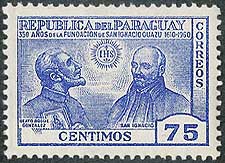
SPAIN, 1936, issued the day after the outbreak of the Spanish Civil
War
by the Junta Central Carlista de Guerra in Burgos
The motto: For the Greater Glory of God and of Spain
The image was inspired by a painting of Jesuit Brother
Martín Coronas (1862-1928)
The Gálvez Specialized Spanish Stamp Catalog, number 142
Ignatius, the founder of the Society of Jesus, was born at Loyola castle, in the Basque Country of Spain in 1491. He was trained in military and courtly ways, but after a serious wound at the Battle of Pamplona in 1521 and a year of prayerful convalescence gave himself dramatically to God in an all-night vigil of arms at the Monastery of Montserrat. During the following year at Manresa near Barcelona he experienced many mystical graces and began his writing of the Spiritual Exercises, which encapsulated his experience and spirituality for the sake of others. His plan to live in the Holy Land fell through, and, going back to school to acquire the credentials to minister to others, he gathered a group of like-minded men around him. These first companions eventually formed the religious order that was approved as the Society of Jesus in 1540. Ignatius was elected the Jesuits' first superior general and spent the rest of his life directing the growing group — more than 1000 members at his death — and writing its constitutions. He was canonized in 1622, and is the patron saint of retreats.
VATICAN CITY, 1946, the 4th centenary of the Council of Trent, Scott 113
based on Jacopino del Conte's painting done immediately after the saint's death.




SPAIN, 1955, the 4th centenary of Ignatius' death, Scott 836-838, and
its FDI cancel
based on a of Alonso Sanchez Coelo's portrait of 1585; the middle value also
pictures Loyola Castle



COLOMBIA, 1956, the 4th centenary of the death of Ignatius, Scott 668,
C287, and C324 (an overprint dated 1959-60)
based on Lorenzo Coullaut Valera's statue located in the saint's bedroom at
Loyola Castle

VATICAN CITY, 1956, the 4th centenary of his death, Scott 212-213
The set, issued on July 31, the death day and feast of St. Ignatius, shows part of the anonymous mid-17th-century painting in the Church of the Gesù in Rome of Pope Paul III approving the Society of Jesus.





PARAGUAY, 1956, the 4th centenary of his death, Scott 520-524, and their FDI cancel
two stamps show a statue, and two stamps portraits of Ignatius and St. Roque Gonzalez, and one the del Conte portrait above the San Ignacio Guazú reduction



PARAGUAY, 1956, like many Paraguayan stamps after 1944, this set exists
in imperforate form








PARAGUAY, 1966, the 350th anniversary of San
Ignacio Guazú, Scott 935-942
the four regular stamps show Ignatius and Gonzalez, the four airmail Ignatius and San Ignacio Guazú type


